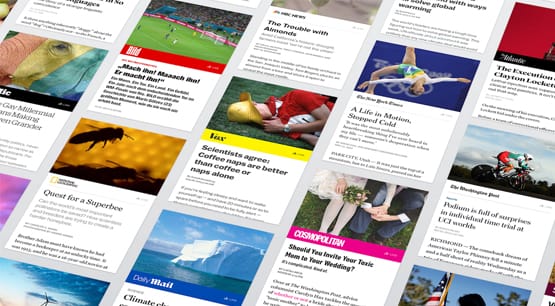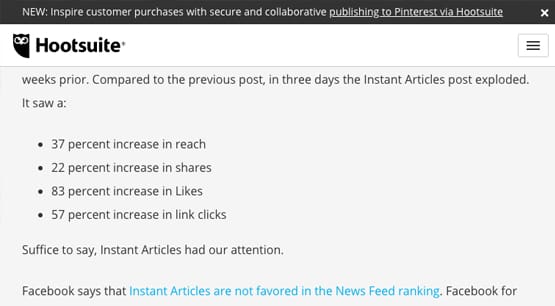Can Facebook Instant Articles Increase Your Post Reach?

Every time Facebook rolls out a new feature, changes an existing feature, or tweaks their algorithm, the one thing everyone wants to know is whether or not that change will affect their reach.
It’s a reasonable question. Reach is important, right? It’s the primary measurement of how many people see your content. So, when Instant Articles first appeared, it came as no surprise that people wanted to know whether or not they would be good to use.
So what are Instant Articles, and can they benefit your page reach if you make use of them?
Instant Articles: A Primer
Instant Articles is a system Facebook has actually had in place since the end of 2015. Many people don’t know much about them, though, because they’re 100% a mobile-focused tool for Facebook, primarily using the Facebook app. People browsing Facebook on the web via PC devices, or even just using the web version on mobile rather than using the official app, won’t experience Instant Articles.
What are Instant Articles? In short, it’s just mobile-formatted content from your own site. When you set up Instant Articles, and once you’re approved to use them, you plug in a content source. Facebook automatically pulls content published to that source. The text and images – as well as video when relevant – is copied over to Facebook’s servers and formatted using their special kind of almost-XML. This is designed primarily for speed on mobile devices, so anyone browsing via the Facebook app can read the articles virtually instantly rather than waiting for slow cell service to load a third party server and render content for them.
If you’ve ever looked into Google’s AMP project, it’s a very similar concept. You’ve probably encountered these. Sometimes, when you tap a result on a mobile device from Google’s search results, you get taken to a sort of sub-app within the browser, that loads the content almost immediately. It’s pleasant, if a little strange the first few times you see it, but the ease of use is worth it.
Facebook Instant Articles have a few great benefits and a couple of nagging drawbacks that make them maybe not a slam-dunk win for marketers, which is why not everyone is using them.
The Benefits of Instant Articles
The number one benefit of using Instant Articles is the speed your content loads. Pretty much all of you know that trying to use a mobile device to browse the internet is often a slow and lag-ridden experience. If you’re not on WiFi, even the best cell service can have issues rendering pages. That’s not to mention all the times you encounter websites that simply don’t have mobile-focused pages at all.
Now, using Instant Articles is not a replacement for having a mobile design. For one thing, it’s a Facebook system, not a Google system. Google won’t rank your content any better for using Instant Articles. They won’t rank you worse, either; it doesn’t matter at all. Google doesn’t browse your content via the Facebook app, so it might as well not exist as far as SEO is concerned.
The second benefit is in terms of advertising. Instant Articles are YOUR content, simply hosted on Facebook servers and provided by the Facebook app. You have some control over how it appears, but not full control, so Facebook can keep things standardized. However, since it’s your content and operates as a sort of hybrid platform between your site and Facebook, you are allowed to advertise in your Instant Articles content.
You’re allowed to run general display advertising, both from systems like AdSense and from other ad networks. If you want, you can also run Facebook’s Audience Network ads, either in place of or in unsold inventory for your main ads.
It should be noted that Instant Articles are not a replacement for RSS-to-Facebook systems. You can set up an RSS feed as your input, and Facebook will automatically create an Instant Article out of new RSS content. However, Facebook does not automatically post that content to your page. You still need to do that manually. If you’re used to a lot of specific automation, it might not work with Instant Articles, so keep that in mind.
Instant Articles require that the content still be hosted on your own site, because again, they only appear via the Facebook app. That said, when you post a link to an Instant Article, it’s still just a link post. You can run it as an ad, boost it, or otherwise target it however you like.
And, of course, I would be remiss if I didn’t mention the very issue in the title of this post. According to Facebook, Instant Articles receive 20% more clicks than non-Instant Articles content. Facebook also claims they get more shares than other links and that people are 70% less likely to abandon an article because it doesn’t load fast enough. Makes sense, right?
Of course, Facebook has a vested interested in promoting their own new systems, so it’s always possible they’re exaggerating. Facebook also claims that Instant Articles are not favored in the algorithm in any way, and are treated just like other links to outside content.
These can both be true, though. Facebook doesn’t have to favor the type of content if the content itself attracts more positive metrics. A fast-loading Instant Article will receive more comments, likes, and shares more quickly, which is a boost to that post’s EdgeRank, which in turn means it’s likely to be given better reach.
Hootsuite corroborates this. They tested out Instant Articles in the middle of 2016 and found that their Instant Articles content received a 37% increase in reach, 22% more shares, 83% more likes, and 57% more clicks than previous content.
Those are some incredibly good numbers! They’re also a little old, so you can bet that Facebook has toned things down a bit. It’s almost guaranteed that you’ll see an increase in reach if you choose to use Instant Articles, but it might not be such an astonishing degree of increase.
Also, you have to keep in mind that all things are relative. If your Facebook audience is relatively small, a 37% increase in reach is within the margin of error of one post simply being more attractive than another. To truly find out of Instant Articles will benefit you, you need to take several months worth of data both with and without, rather than just comparing individual posts.
The Drawbacks of Instant Articles
The number one drawback of Instant Article publication is that the content is on Facebook, albeit in a sort of sub-site, rather than on your own site. All of those fancy sidebars, calls to action in your navigation, sliders, pop-overs, and assorted other techniques meant to cajole people into signing up for your newsletter or buying your service? None of that carries over. Facebook is serving your content and your display ads, and that’s pretty much it.
Now, Facebook does allow you to use most third party analytics suites, like Google Analytics, with Instant Articles. Traffic from Facebook to an Instant Article is still recorded, it’s not somehow lost traffic. However, it can be more difficult to capture those visitors and keep them around on your site, since you still have to get them TO your site in the first place. It adds another barrier to entry.
If you’re making money solely from your display ads, of course, this doesn’t matter. If you’re trying to build a mailing list, get clicks to sidebar ads, or sell a product on your own site, you lose out on a lot of the power of your calls to action. You need to then focus more heavily on in-content links that ferry people to your website or directly to your landing or store pages, which then encounter the same sort of delayed loading you might have with the initial click without Instant Articles.
The primary drawback of using Instant Articles is actually the setup cost. You have to apply to the Instant Articles system, and you have to submit TEN samples of your posts, so Facebook can make sure they fit the kind of content they want using the Instant Articles system. It’s not unheard of for some sites to be rejected, though it’s not exactly common.
More importantly, you need to then set up the system for publishing Instant Articles. Again, similar to Google’s AMP content, you need to include formatting tags in your content so Facebook’s bots know what to pull and what to ignore.
What this mostly means is that you need specific meta data in your web posts for Instant Articles to be able to pick them up. You need a canonical link, you need specific data and media for the special header and logo Instant Articles generates, and some other code. You or your developer can read all about that in the actual Instant Articles developer section, once you’ve been approved to use the system in the first place.
One fringe benefit for WordPress users is that Facebook developed an actual plugin to help with formatting and adding all the meta code for Instant Articles. You can read more about the plugin here.
All Instant Articles need to comply with the IA-specific policies on Facebook. These policies primarily include content and formatting restrictions, similar to the restrictions on destinations of Facebook ads. If you aren’t approved for ads, you probably won’t be approved for Instant Articles either. Anyway, make sure to review the policies before you apply.
Should You Use Instant Articles?
So, what’s the verdict? Should you actively use Instant Articles, or are they not worth the effort?
First of all, if you have a lot of followers who use the Facebook App rather than PC browsing or normal web browsing, Instant Articles can be appealing. They’re faster than web browsing normally, and they tend to attract more reach and engagement.
Secondly, those reach numbers look very good. If you can achieve an increase in reach, why not give it a shot?
On the other hand, if you don’t have a sizable contingent of mobile users, specifically using the app, it’s a lot of work to set up for nothing. If no one uses the app, no one sees Instant Articles, so you don’t get the benefit of using the system.
More importantly, if you’re heavily reliant on pop-overs, Hello Bar-style drop shutters, sidebars and sliders, or any other sort of on-side call to action, you lose out a lot of that benefit. Again, though, that only applies to people using the Facebook app itself.
For a lot of relatively small businesses, it might not be all that valuable to add Instant Article support. On the other hand, if you can set it up, you don’t usually lose much. It’s probably worth a try! You’ll likely see increased post reach, but you might see decreased onsite conversions, so measure both kinds of metrics and see which is more important.








